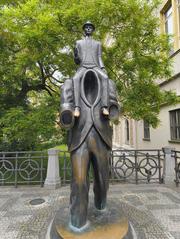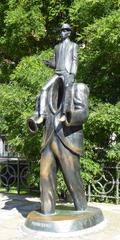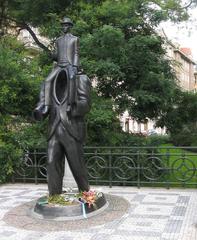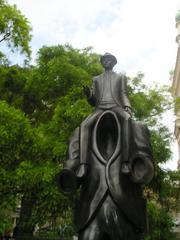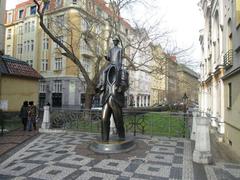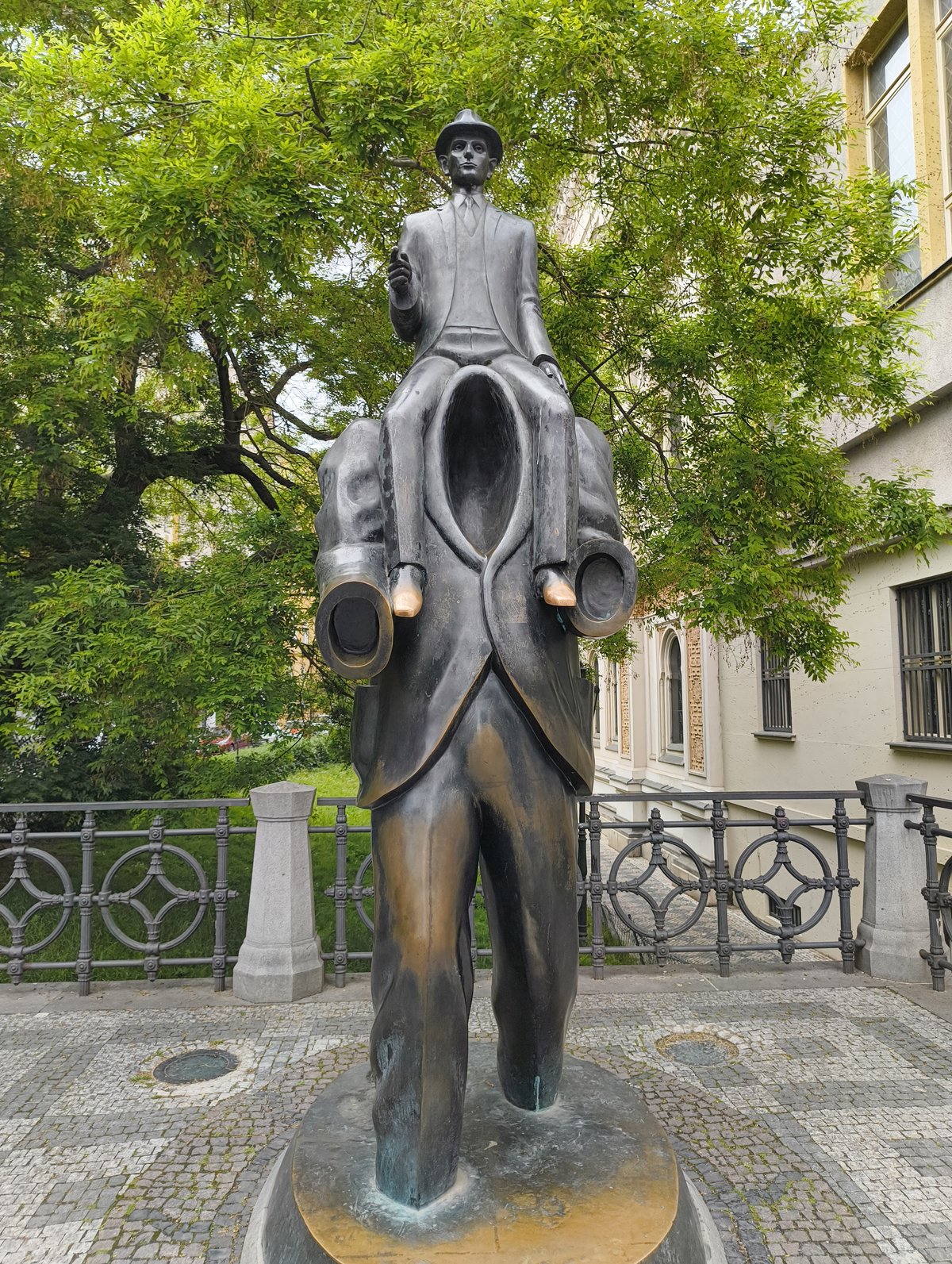
Statue of Franz Kafka Prague: Visiting Hours, Tickets, and Complete Guide
Date: 15/06/2025
Introduction to the Statue of Franz Kafka in Prague
Prague, a city renowned for its vibrant culture and historic architecture, pays homage to one of its most influential literary icons, Franz Kafka, through two remarkable public art installations: the bronze Franz Kafka Statue by Jaroslav Róna and the kinetic Rotating Kafka Head by David Černý. These installations not only celebrate Kafka’s enduring literary legacy but also provide tangible entry points into the existential themes that permeate his work—identity, alienation, and the absurd.
Both monuments are freely accessible and situated outdoors, making them easily included in any Prague itinerary. The bronze statue, located in the atmospheric Jewish Quarter, draws its surreal form from Kafka’s early writing, while the kinetic sculpture near the Quadrio Shopping Centre mesmerizes with its shifting stainless steel layers, reflecting the complexity of Kafka’s psyche. When combined with a visit to nearby attractions such as the Franz Kafka Museum, Old Jewish Cemetery, and historic cafés, these statues offer a rich, immersive journey through Prague’s literary and cultural heritage.
This detailed guide covers everything you need to know—visiting hours, locations, accessibility, photography tips, and nearby Kafka-related sites—ensuring an informed and memorable encounter with Kafka’s Prague (Atlas Obscura, View from Prague, Prague City Tourism).
Contents
- Introduction
- About the Franz Kafka Statues
- Visiting Hours and Admission
- Locations and Accessibility
- Nearby Attractions and Travel Tips
- Who Was Franz Kafka? (Overview)
- Kafka’s Connection to Prague
- FAQs
- Kafka Statues in Prague: In-Depth Overview
- Jaroslav Róna’s Franz Kafka Statue (2003)
- David Černý’s Rotating Kafka Head (2014)
- Kafka Museum: Visitor Information
- Comparative Table: Kafka Statues
- Additional Kafka-Related Sites
- Planning Your Visit: Practical Tips
- Visuals and Interactive Resources
- Conclusion: Experiencing Kafka’s Prague
- Sources and Further Reading
About the Franz Kafka Statues
Jaroslav Róna’s Franz Kafka Statue (2003)
Unveiled in 2003 in Prague’s Jewish Quarter, this surreal bronze statue by Jaroslav Róna is inspired by Kafka’s short story “Description of a Struggle.” It depicts Kafka astride the shoulders of a giant, empty suit—an image representing themes of existential uncertainty and personal duality. A beetle outline at the statue’s base alludes to “The Metamorphosis,” another of Kafka’s seminal works.
- Location: Dušní Street, between the Spanish Synagogue and the Church of the Holy Spirit, Prague 1
- Height: 3.75 meters
- Artistic Style: Surrealist bronze
- Symbolism: Alienation, identity, the absurd (Delve Into Europe)
David Černý’s Rotating Kafka Head (2014)
Located outside the Quadrio Shopping Centre in New Town, the Rotating Kafka Head is a kinetic marvel unveiled in 2014. Composed of 42 stainless steel layers driven by precision motors, the sculpture periodically aligns to form Kafka’s face before dissolving into abstraction—an apt metaphor for the shifting nature of identity and consciousness.
- Location: Spálená 2121/22, in front of Quadrio Shopping Centre, Prague 1
- Height: 11 meters
- Artistic Style: Kinetic, modern stainless steel
- Symbolism: Fragmentation, psychological complexity, transformation
Visiting Hours and Admission
- Statues: Both the bronze Kafka Statue and the Rotating Head are outdoors and accessible 24/7, free of charge. No tickets or reservations are required.
- Kafka Museum: Open Tuesday to Sunday, 10:00 AM – 6:00 PM; closed Mondays. General admission is approximately 200 CZK (discounts for students and seniors). (Kafka Museum)
Locations and Accessibility
Kafka Statue by Jaroslav Róna
- Address: Dušní Street (between Spanish Synagogue and Church of the Holy Spirit)
- How to Get There: Five-minute walk from Staroměstská metro station (Line A); reachable by trams 2, 17, and 18
- Accessibility: The area is pedestrian-friendly; cobblestones may require minor assistance for those with limited mobility
Rotating Kafka Head by David Černý
- Address: Spálená 2121/22, adjacent to Národní třída metro station (Line B)
- How to Get There: Directly at Národní třída metro and tram stops (2, 9, 18, 22)
- Accessibility: The piazza is flat and paved, suitable for wheelchairs and strollers
Nearby Attractions and Travel Tips
- Best Time to Visit: Early mornings or late evenings for fewer crowds and optimal photography
- Photography: Both statues offer compelling photo opportunities, with reflective surfaces and historic backdrops
- Nearby Sites: Spanish Synagogue, Old Jewish Cemetery, Franz Kafka Museum, Café Louvre, Café Arco
- Amenities: Restrooms and cafes are available in the Quadrio Shopping Centre
- Guided Tours: Many walking tours include Kafka landmarks and provide literary context
Who Was Franz Kafka? (Overview)
Franz Kafka (1883–1924) was a German-speaking Jewish writer from Prague, whose works explore alienation, bureaucracy, and existential dread. Though he published little in his lifetime, Kafka’s influence on literature, philosophy, and the arts is profound. His major works include “The Metamorphosis,” “The Trial,” and “The Castle,” and his legacy is inextricably linked to Prague’s cultural identity.
Kafka’s Connection to Prague
Prague’s labyrinthine streets and multicultural character shaped Kafka’s worldview and writing. The statues’ locations in the Jewish Quarter and New Town highlight both Kafka’s heritage and the city’s ongoing embrace of its literary past.
Frequently Asked Questions (FAQ)
Q: What are the visiting hours for the Kafka statues?
A: Both statues are accessible 24/7; the Rotating Head’s kinetic movement occurs from 9:00 to 23:00, during the first 15 minutes of each hour.
Q: Is there an entrance fee or tickets required?
A: No, both statues are free and open to the public.
Q: Are the statues accessible for people with mobility challenges?
A: Yes, both locations are in pedestrian zones with flat or gently sloping surfaces.
Q: Can I photograph the statues?
A: Yes; photography is encouraged.
Q: What other Kafka-related sites can I visit?
A: The Franz Kafka Museum, Kafka’s childhood home, House at the Minute, and several literary cafés.
Kafka Statues in Prague: In-Depth Overview
Jaroslav Róna’s Franz Kafka Statue
- Inspired by: “Description of a Struggle”
- Unveiled: 2003
- Weight: Approx. 800 kilograms
- Public Reception: A beloved symbol of Prague’s Jewish Quarter and literary history (Radio Prague International)
David Černý’s Rotating Kafka Head
- Unveiled: 2014
- Technical Details: 42 stainless steel layers, 21 motors, 39 tons, aligns to form Kafka’s face twice per hour between 8:00 and 19:00
- Artistic Significance: Represents Kafka’s fragmented identity and the psychological themes in his literature (View from Prague, Public Delivery)
- Best Viewing Times: On the hour, for the kinetic transformation
Comparative Table: Kafka Statues in Prague
| Aspect | Jaroslav Róna’s Statue | David Černý’s Rotating Kafka Head |
|---|---|---|
| Year | 2003 | 2014 |
| Height | 3.75 m | 11 m |
| Location | Dušní Street, Old Town | Quadrio Shopping Centre, New Town |
| Artistic Style | Surrealist Bronze | Kinetic Stainless Steel |
| Accessibility | 24/7, free | 24/7, free |
| Symbolism | Identity, alienation | Fragmentation, transformation |
Additional Kafka-Related Sites
- Kafka’s Birthplace and Residences: Plaques in Old Town and Jewish Quarter
- Literary Cafés: Café Louvre, Café Arco
- House at the Minute: Kafka’s former residence on Old Town Square
Planning Your Visit: Practical Tips
- Wear comfortable shoes for cobblestone streets
- Plan visits on the hour to see the Rotating Head’s movement
- Combine statue visits with the Kafka Museum for a deeper dive
- Check for special literary events or guided tours
Visuals and Interactive Resources
- High-quality images and virtual tours are available via official tourism sites and the Quadrio website
- Interactive maps and travel planners help optimize your Kafka-themed itinerary
Conclusion: Experiencing Kafka’s Prague
Prague’s Kafka statues are more than monuments—they are interactive gateways into the mind and world of Franz Kafka. From the surreal bronze figure in the Jewish Quarter to the mesmerizing kinetic head in New Town, these landmarks offer memorable insights into the existential themes that define Kafka’s work and legacy. Whether you are a literature enthusiast or a curious traveler, these statues are essential stops on any cultural journey through Prague.
For the latest updates, guided tours, and exclusive insights, download the Audiala app and follow Prague’s cultural channels on social media. Embark on a unique exploration of Kafka’s Prague and experience public art that continues to inspire and intrigue visitors worldwide (Radio Prague International, Expats.cz, Quadrio).
Sources and Further Reading
- Atlas Obscura – Visiting the Statue of Franz Kafka in Prague: History, Hours, and Tips
- View from Prague – Franz Kafka Statues in Prague: Visiting Hours, Tickets, and Historical Insights
- Radio Prague International – Discovering Kafka Statues in Prague: A Visitor’s Guide to History, Art, and Practical Information
- Quadrio Shopping Centre – Visiting the Moving Head of Franz Kafka Statue in Prague: Hours, Tickets, and Tips
- Prague City Tourism – Statue of Kafka
- Expats.cz – Inside Kafka’s Head: Prague’s Most Famous Moving Sculpture to Get Makeover
- Quadrio Shopping Centre – Franz Kafka Statue
